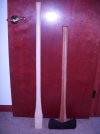Among the few comments thus far to The De-Evolution of Ax Handles, the one most crying for a response is from rg598 aka "Woodtrekker", a man committed to informing the public on ax-related matters. But this time he did not say anything imminently useful - and I would not have taken time to respond at all, were it not for his needless disparaging of an excellent treatise, one which, in my view, belongs on the bookshelf of every serious student of the ax. Here is what he had to say:
The article is very well written and informative, but Im not a big fan of telling people what the ultimate truth is about anything. The reality is that all experienced outdoorsmen disagree on just about everything, and in the history of axes, we would be hard pressed to find two people who agreed on anything, let alone handles...
Some food for thought to the trekking man:
As a prelude to the rebuttal that your kind of comments call for, let me express some regret that the person a short time ago I hoped might become a creative Gespraechspartner on the subject of axes, now turns out to be a sparring partner instead. (For the benefit of English speakers: the literal translation of this common German term is a debating partner. However,
the debate meant here is not of the kind politicians usually indulge in; your Gespraechspartner is not your critic per se but rather a useful two-way conduit for an exchange and refinement of ideas.)
That hope stemmed from the fact that we obviously have some deep-rooted commonalities: both born and raised in close to the same spot of the globe (and under the communist rule to boot), far away from the culture we live in now. The axes that both our grandfathers used and/or those we had a chance to try out as teenagers were still a far cry from what most American
ax-men had already been using for well over a century. We both seem to dance to the beat of different drummers, rather than following the herd along the mainstream path - and for that reason we both question much of what we are told.
Ive always sought and appreciated differing points of view, spun them over in my mind (sometimes letting them ferment over a long period of time) -- and learned much by it all. When I began to pick the brains of the seasoned country folk (first in Ontario and, as of 1976, here in New Brunswick) I quickly realized that it was better to talk less and listen more. Though they all were mostly very likable and unassuming, the old New Brunswick men in particular were certainly a strongly opinionated lot. That aint no good for nothing was one of their common expressions. But in areas where they had far more experience than I, it would have been foolish to write them off too quickly and not continue hearing what they had to share.
Unfortunately, you perceived my, as well as Dudley Cooks, sharing as a threatening voice from some pulpit of truth - and reacted accordingly. May the woodland faeries forgive you! I will be less nice, however, because from any which angle I view your words, what I mostly perceive is: this fellow is determined to argue, period.
To briefly summarize some of what you contested -- but which
did not at all appear in my article:
1. The words ultimate, truth, the exact right proportions and never.
2. Stating that a 1975 commercial version - or
any other specific size/design of an ax handle -- is some ideal version for everyone to copy.
3. That nobody still makes very thin handles.
4. ...that two handles from the same material (could not) have the same springiness even though they are different thicknesses.
(A hint: it would have been more accurate if you had said "species of wood" instead of material; the
same material, technically speaking, implies - besides the sharing of other characteristics -- the
same springiness. With regard to what you were attempting to express - yes, you are right. However, my piece was an introduction only to a rather large subject - one
Im by no means finished with.)
5. That a curved handle represents some new post-vanilla ice cream flavor.
(The American curved handles have been around for over a century and a half. Besides, the article is meant as
practical advice on what people can do
now.)
Combined, those were a lot of paper dragons to fight... (or "straw men"...)
Now to your actual comments: Already in your first sentence you make a gross overstatement, which then seems to form the basis for the rest of your remarks. Coincidently, in your next sentence you put your foot in your mouth. (Have you considered what exactly the difference is between ...
the ultimate truth is... and
The reality is...)
Because it could take us further away than necessary from the theme of axes, I wont dwell on your reference to the experienced outdoorsmen. As for the rest of that paragraph -- your statement ...i
n the history of axes, we would be hard pressed to find two people who agreed on anything, let alone handles is simply humbug.
Based on my travels and extensive interactions with farmers in various countries, I happen to have a bit of background in the realm of the design of agricultural hand tools. Whether I examine axes found on several-generations-old homesteads in Switzerland, Austria, Germany or Slovakia, it is evident that there is actually an uncanny cultural homogeneity when it comes to handles and it is the same with scythes (my special interest), hay and manure forks, hoes or shovels, both in Europe as well as here in North America.
Although with the proliferation of the chain stores this formerly strong
regional uniformity has become somewhat diluted, it still exists for the most part. This, if anything, speaks of
consensus not between any two people, but hundreds (in many cases thousands) of them. Agreements on many issues (including tool design) were, in fact, both practical and necessary because historically there was very little room within the working segment of any society to indulge in the kind of individualism we can presently exercise in this land of milk and honey.
(Still, your own ax is outfitted with an
industrially-made handle, which not you but someone else decided on the exact dimensions of. That someone is
already at least one person you
agree with on the issue of handle size - and you share this agreement further with the thousands of others who now use their Granfors axes
without having altered the handles in any way. In my view, this is a statement to the fact that agreements between people are far more frequent than you are willing to admit. Examples of this sort are plentiful indeed.)
Furthermore, contrary to what you say (....
for a large part of its history, the axe was hung on hand made handles designed based on family tradition), most families did
not make their own tool handles. I do not see a reason to delve here into the axs entire existence (from the stone age on), but during the last several centuries in each village or settlement there was a man, or several, who made tool handles for the whole extended countryside community, simply because they could do it more efficiently. Yes, a (smaller) portion of handles were always made by their users, and still are; nevertheless they too adhere to the respective cultural tradition regarding the basic design and material dimension. The personal touch was/is mostly
confined to decorative carving, or details such as the specific shape of a snaths grip, for instance, rather than alteration of anything fundamental.
In most of Europe a knob on an ax handle is a relatively recent introduction; in many parts still non-existent. Had it been otherwise each knob would likely be a recognizable feature matching the handle to its maker, be he a grandfather serving only one familys needs, or a professional tradesman.
In the much more culturally intermixed North America the situation was somewhat different, at least in the beginning when new immigrants had to be more self-reliant. Yet eventually some solid agreements were reached, even here. By the time the ax industry was in full bloom, thousands of handles were manufactured commercially - and to certain agreed upon specs. The handle patterns varied greatly, the total length less so and the dimension of the shaft the least. Many companies made only two thickness sizes regular and slim. Some added extra slim.
Did
most lumberjacks customize the shaft thickness of purchased handles? I do not know, but having to date come across no written evidence to that effect, I dont think this was the case. Then and now, people are known to generally accept many things as they are presented to them without ever trying an alternative. Yes, yes, there are exceptions though I think that
this is the rule. (And it is precisely the insidious nature of some of similar rules in this case the blind acceptance of ever stiffer handles that my De-Evolution article addresses.)
I had included a remark that I was surprised to find the dimension of the three photographed samples (made by three different men) to be all the same. Though I had long known that a slim handle was the rule around here I hadnt measured a heap of them at once until recently and it was yet another case of agreement.
There were still about a dozen small-scale ax handle makers within a 20 mile radius of our farm when we moved here in 1980. Only two of them used lathes; the rest did it freehand. I knew several of them personally, and have samples of their work; all are within 1mm from each other in width and thickness.
If you asked these men how thick an ax handle ought to be, most would likely just say pretty thin; if pressed for actual size of thin, it might be Oh, about 3/4. In reality their handles - made mostly of rock maple or ash (hickory doesnt grow here) -- were a shade thinner than that. And they did not, as a rule, make ...
different thickness handles... to accommodate different
size of hands, arms, etc.. (Neither does Granfors Bruks nor Wetterlings for that matter...) Whether this was a serious shortcoming I dont know. Suffice it to say that some short men with small hands, as well as those with bear-like stature, all used them with apparent satisfaction. Perhaps they were too dumb to know that they are all individuals entitled to a very tailor-fit ax handle... and some of the poor buggers consequently ended up with them inappropriately-sized.
Now, as to your help with clarifying the concept of too much -- of course, a tool handle can be made too light and/or too springy and I did not claim otherwise (though I did not know that too much give is worse than too little). However, to extrapolate as you do -- without being specific - is, in the context of this discussion, quite useless. If instead, you had stated, for instance, that you consider a 16x33, or even 18x36 mm handle section too limber for say a 3½ lb head (especially if it is over 30 long) but perhaps OK on a 2 lb head (and if made of first grade hickory) it might do for the average person (but not the kind of forceful chopping you indulge in) - or something along those lines -- youd be providing what I consider constructive feedback. That is what I asked for and hoped to receive.
As it is, your buckshot comments indicate that you probably have not actually seriously used an ax with the handle dimensions close to the slim ones I listed.
Beyond sharing that my family has over a period of years regularly used - not just quickly tested -- some uncommonly thin handles, I offered dimensions of concrete examples. But lets discount the validity of our experience - maybe my daughters, my son and I are all wimps, reluctant to use an ax with force.
Still, you question whether those unknown-to-you old men had it exactly right. What I can say in response is though you can rant all you want about some arbitrarily too springy handles, the functionality of the local standards was proven by the fact that thousands of trees were felled by them. The supposed eccentrics who swung them probably represented one of the last
segments of this continents serious axmen.
As some readers may know, New Brunswick is a somewhat backwards province of Canada, with about 80% of its surface in forest, and where the first awkward chainsaws werent introduced until the mid-to-late fifties. The old woodcutters werent enamored of the initial models because the chainsaws wouldnt start on cold mornings nor after they became somewhat hot in use, and the men here famously joke how the chain moved so slow while cutting that you could file it at the same time. So the ax did its share of work long after that.
In any event, still only a couple of generations ago many a farm-raised boy of 14 or so quit school and joined his father for a wintertime spell in one of the many lumber camps. The tradition here was that with the first solid ground freeze (usually early November) the average small farmer left the homestead in the care of his wife and children to become a seasonal lumberjack. Sometimes he returned home for Christmas and left again shortly thereafter to stay in the camp until the spring break-up.
In the lumber camp the men had breakfast and harnessed the horses by the light of the kerosene lanterns. They were in the woods ready to swing the axes at the crack of dawn. In the evening (again by the lantern) the axes were re-shaped from eye to the bit on large sandstone grindstones, to make sure they met the old Canadian standard of severing a 4 inch trunk
(usually the treetop) in no more than two strokes and sinking half way up the bit if driven cross-grain into green wood.
Felling 50 trees per man was a common daily quota. So clearly, those were working men whose livelihood was dependent on axes. Yet, on top of being uncommonly thin, their handles didnt have what you call power steering (they used exclusively the double-bitted models) and God only knows how much of what you call wrist rotating they consequently had to accept in order to accomplish what they did. (I must admit to being stumped as to what you are talking about.)
Could it be that the difference between you -- taught to use force in a typical Western manner -- and them was that, though living long way from China, they grasped the principles of Tai-chi when it came to axmanship??
[To be immediately continued]








